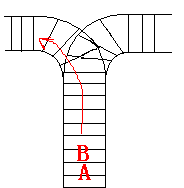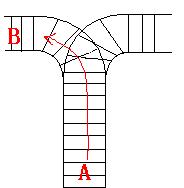Problem A
Time Limit : 2000/1000ms (Java/Other) Memory Limit : 65536/32768K (Java/Other)
Total Submission(s) : 49 Accepted Submission(s) : 21
Problem Description
As the new term comes, the Ignatius Train Station is very busy nowadays. A lot of student want to get back to school by train(because the trains in the Ignatius Train Station is the fastest all over the world ^v^). But here comes a problem, there is only one railway where all the trains stop. So all the trains come in from one side and get out from the other side. For this problem, if train A gets into the railway first, and then train B gets into the railway before train A leaves, train A can't leave until train B leaves. The pictures below figure out the problem. Now the problem for you is, there are at most 9 trains in the station, all the trains has an ID(numbered from 1 to n), the trains get into the railway in an order O1, your task is to determine whether the trains can get out in an order O2.






Input
The input contains several test cases. Each test case consists of an integer, the number of trains, and two strings, the order of the trains come in:O1, and the order of the trains leave:O2. The input is terminated by the end of file. More details in the Sample Input.
Output
The output contains a string "No." if you can't exchange O2 to O1, or you should output a line contains "Yes.", and then output your way in exchanging the order(you should output "in" for a train getting into the railway, and "out" for a train getting out of the railway). Print a line contains "FINISH" after each test case. More details in the Sample Output.
Sample Input
3 123 321 3 123 312
Sample Output
Yes. in in in out out out FINISH No. FINISHFor the first Sample Input, we let train 1 get in, then train 2 and train 3. So now train 3 is at the top of the railway, so train 3 can leave first, then train 2 and train 1. In the second Sample input, we should let train 3 leave first, so we have to let train 1 get in, then train 2 and train 3. Now we can let train 3 leave. But after that we can't let train 1 leave before train 2, because train 2 is at the top of the railway at the moment. So we output "No.".HintHint#include<iostream> #include<stack> #include<vector> #include<cstdio> #include<cstring> #include<string> #include<algorithm> const int MAX=301; char in[MAX]; char out[MAX]; using namespace std; int main() { int n,i,j; stack<int>s;//定义一个栈 vector<string>stl;//定义一个动态数组 while(cin>>n>>in>>out) { i=0; j=0; while(i<n) { s.push(in[i]); i++; stl.push_back("in");//进栈 while(!s.empty()) { if(s.top()==out[j]&&j<n)//如果是先进又是先出或者先进最后出 { stl.push_back("out"); j++; s.pop();//每次出栈后都要释放 } else break; } } if(s.empty())//如果栈空就说明是符合的 { cout<<"Yes."<<endl; for(i=0;i<stl.size();i++) cout<<stl[i]<<endl; cout<<"FINISH"<<endl; } else//否则不是符合的 cout<<"No."<<endl<<"FINISH"<<endl; stl.clear(); for(i=s.size();i>0;i--)//每次输出完都要清空栈,不然会WA,因为系统测试数据时用同一个栈,不清空会和上一个测试数据混淆 s.pop(); } return 0; }






















 1024
1024

 被折叠的 条评论
为什么被折叠?
被折叠的 条评论
为什么被折叠?








